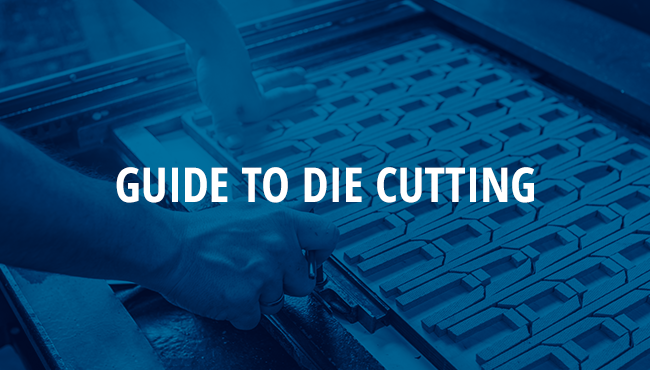


The capabilities of die cutting are vast and include a variety of commercial, industrial and consumer-grade goods. Its versatility makes it suitable for various projects, but die cutting is more effective for some needs than others. Recognizing when to choose this manufacturing method and understanding its limitations will increase the chances of getting the results you want. Discover everything you need to know about this process in our guide to die cutting below.
Die cutting cuts pre-determined forms into thin material, such as rubber, foam, plastic, wood, metal and fabric. The process can take several forms. Common die cutting methods include using a laser, implementing a rotary tool or creating a custom die for punching out forms.
Die cutting has existed for almost 200 years. Not long after the Industrial Revolution, die cutting used a punch to press holes into leather manually. This form of cutting initially helped shoemakers produce shoes more uniformly and at a faster pace by creating precisely cut pieces of leather. Over time, die cutting evolved to become more automated and cut into different types of materials. Today, many industries, from electronics to medical products, take advantage of the customizable forms die cutting can create in large quantities.
The die cutting process depends on the type of equipment used, but it involves choosing the material and selecting the right equipment for the job. For methods that don’t use lasers or a rotary tool for cutting, you may need to create a die.
The three main methods for die cutting include steel rule, rotary and laser. Each process has separate pros and cons, and the same die cutting method may not work for every project. The methods for die cutting include:
The type of die cutting method that works best for you depends on your project requirements. For mass production, a steel rule cutting with a customized die is best. If you already have dies, you can use this method for whatever project the shape of the die accommodates. For heavier materials, the steel rule cutting method works well because the bed supports the weight of what you’re cutting.
Rotary cutting makes objects like gaskets easily. It can cut materials like fabric, plastic and sheet metal and offers a quick turnaround for high-volume projects.
Laser cutting is a method that professional die cutting businesses use. This type of cutting works best for high-precision work required by electronics and similar industries. Beginners don’t often use this method because of the equipment involved.
Die cutting has countless uses. For example, die cutting with a rotary cutter often crafts gaskets out of elastomers or rubbers. Laser cutting can help create electrical insulation to meet the high standards of military equipment. Customized packing inserts made from die-cut foam offer specific forms cut into material to safely cradle the packed products.
As a beginner, you may want to start with paper, fabric or leather die cutting. These materials are easier to cut through. For beginners, crafting projects such as gift cards, holiday decorations, scrapbooking materials, labels and gift tags are ideal places to begin.
For die cutting, the materials used depend on the type of machine you’re working with. For most beginners, a steel rule on a piece of flat material will suffice. Make sure the die will cut through what you want to work with. The amount of pressure used will determine whether the die goes through the piece or creates an imprint, scoring into the material without cutting through it.
A cutting pad under the material can protect the surface underneath, whether it is the die cutting flatbed or another surface.
Paper, fabrics, leather, wood, metal, plastic and foam are commonly used with die cutting. Find these materials for die cutting and others from hobby stores, craft shops or online.
When die cutting initially, avoid using extra-thick materials that would require too much pressure from a die. You also cannot use materials too thick to pass through the machine.
One of the most common mistakes with die cutting is the die failing to cut all the way through the material. This error can happen if the die does not have enough pressure behind it or if the material is too thick to cut. Try sending the material through the machine a second time or adding a piece of cardstock or bulking material under the project to bring it closer to the die and increase pressure. If these options fail, consider replacing the die — it may have a defect.
Depending on your experience with die cutting and what you’re trying to achieve, you may find potential pros and cons to the process. Understanding those advantages and disadvantages can help you make the right considerations for your project.
Die cutting provides multiple advantages for projects that require it, including:
Die cutting is great for thin materials, but it does not work for all projects. For instance, thick materials or different ones at the same time in the cutter may not work.
Additionally, not using a die cutter properly could result in scoring the material instead of cutting through it. Trying to fix this error by running the project through the machine again could fix it. But if the material shifted between the first and second passes, the second cut may not align with the first, creating a misshapen cutout.
The steel rule dies and rotary cutters are also very sharp. Mishandling of them could result in physical injury. And if you need highly precise cutting, you’ll likely not have access to the laser die cutting machines required.
Professional die cutters with more precise machinery can overcome these disadvantages. Experts know how to control the die cutter’s pressure based on the material to ensure proper cutting. Plus, they can use laser cutting for accurate die-cutting results.
Don’t risk making a mistake on die cutting projects that require extra skills to achieve. Instead, request professional die cutting to have a quality job done. Die cutting services from a professional company with the right materials and equipment can help you complete your projects.
When your beginner die cutting skills don’t meet the needs of a specific task, contact American Micro Industries for a free quote for our expert die cutting services. We’re also happy to answer any questions or provide more information about our company and services.